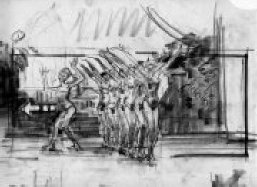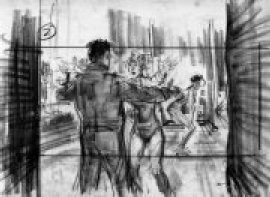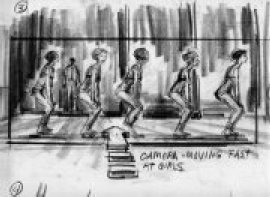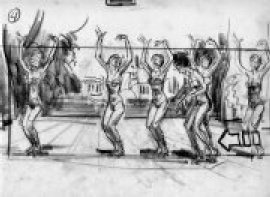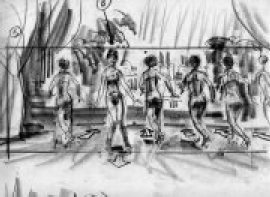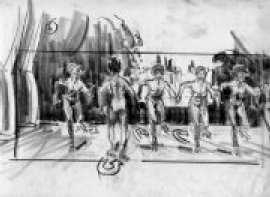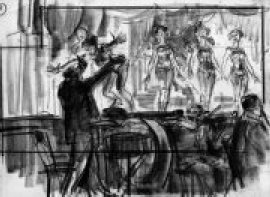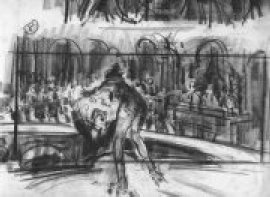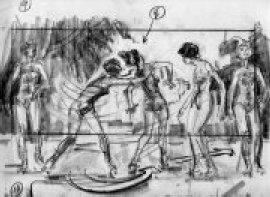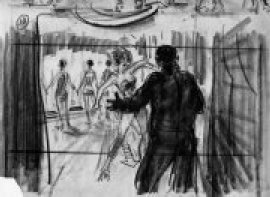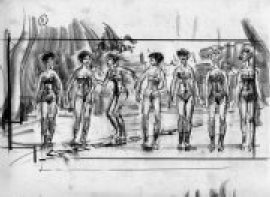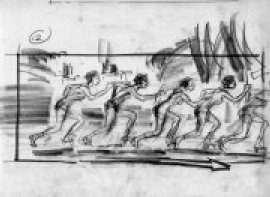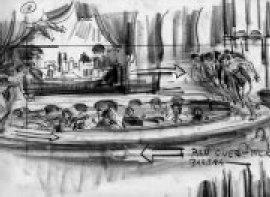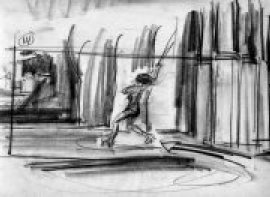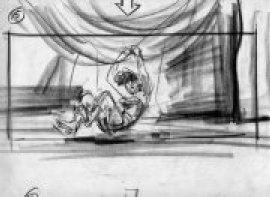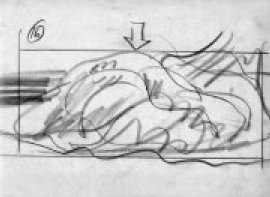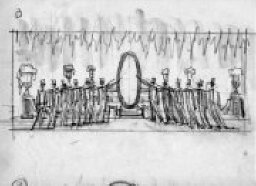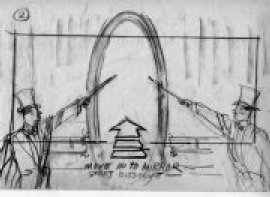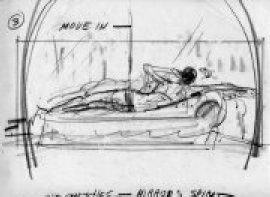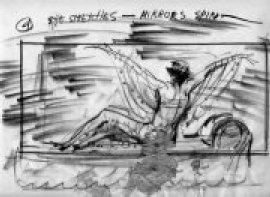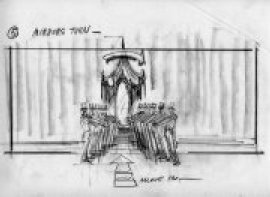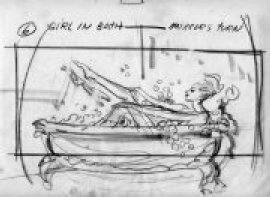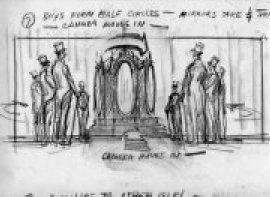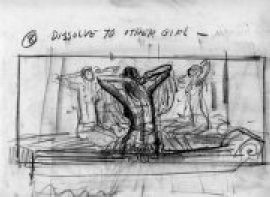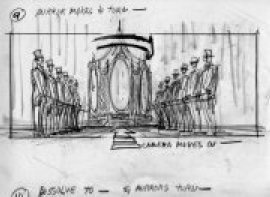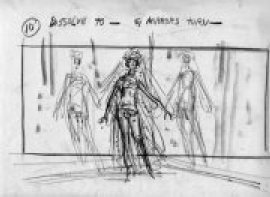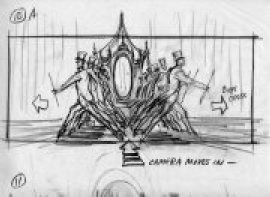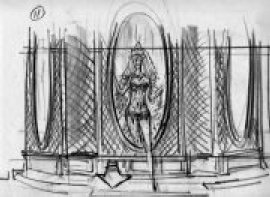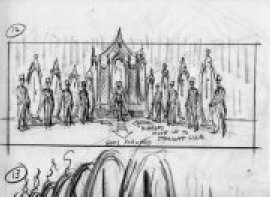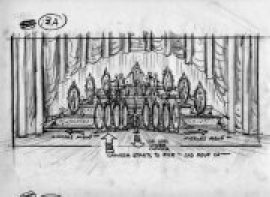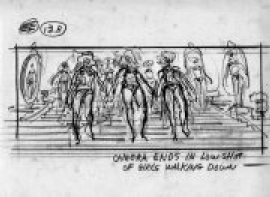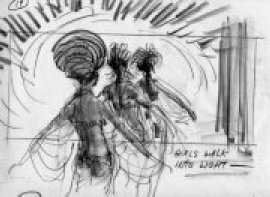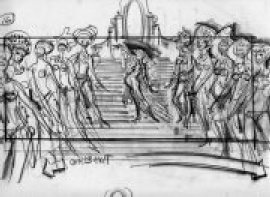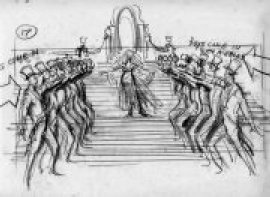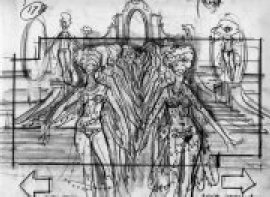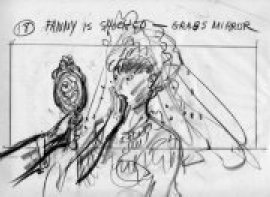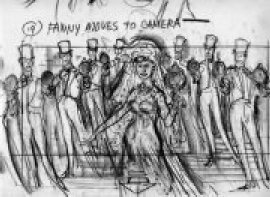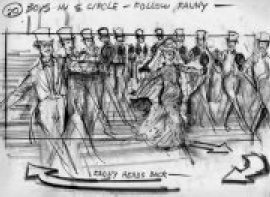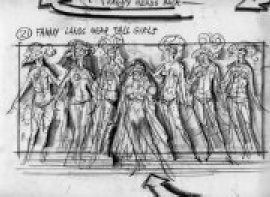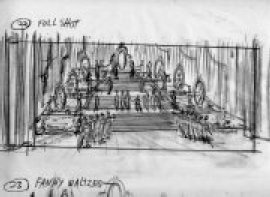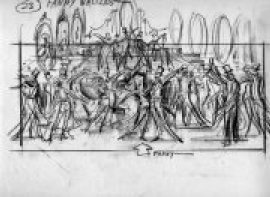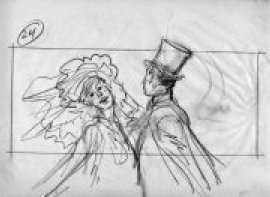MENTOR'S
DRAWINGS
FILM
PRODUCTION DESIGNS
FUNNY
GIRL ~ FUNNY LADY
Barbra Streisand Musical 1975
The Story of Fanny Brice
Producer's Planning Meeting: Preliminary Continuity
Rough Designs
Mentor Huebner (c) 1975
Charcoal on Sketching Pad 8.5" x 11"
Mentor
Huebner, usually worked on movie projects alone in his own studio.
As a 'plein aire' painter he would of course paint outdoors, but
his film production designs, were usually accomplished in his
own studio at his own drawing board.
Or, once-in-a-while, he might work at a quickly set up temporary
office at one of the movie studios. At least that was his modus
operandi after he became popular and sought after and could call
his own career shots.
But everything depended upon time and circumstance. If it was
a rush job, then after a meeting, if he needed to get the work
to the producer or director within a couple of hours, he would
remain at a Motion Picture Studio, and work from there.
There were a lot of meetings. The Producer, the Director and Mentor
might get together to talk things over. Mentor made notes. Visual
notes. They were a sort of visual shorthand. Fast sketches.
When Mentor began any project, first he would either
read ‘the book’ from which the movie was to be made.
Or he would read one of the multiple versions of a ‘script’.
There were always many script changes. Sometimes, the studio would
forget to send Mentor the new script. He might work for days on
one that had been discarded.
Once for the picture DUNE, Mentor continued working from the end
of March to the middle of May before anyone at Universal Studios,
realized they had sent him the wrong outdated script. But the
script was expendable. It changed dramatically and frequently.
Many times Mentor would be working on one, while the writers were
busy rewriting another script. No one ever informed him in a timely
fashion. But even so, often after everyone saw Mentor's ideas
(which he would create on his own) it would tend to convince them
that maybe they should re-think the scene. It's a pressured job.
It's a field where all who strive for perfection are not afraid
to change their minds.
Mentor was a ‘speed’ reader. I can't decide if he
was faster at reading than drawing, or faster at drawing than
reading. It was probably a tie. He drew as fast as some people
sign their names. It was almost automatic.
Many times, as for example when he was hired by Darryl Zanuck
for the 20th Century Fox film, the Longest Day ~ there was no
script. For that film, only Cornelius Ryan’s book existed.
Mentor read the book during his flight to Paris. The minute he
arrived in Paris he was expected to start turning out ideas. Zanuck
first set him up in his office on the Champs-Elysee, in Paris,
then a ship docked in Corsica, and then a Grand Ballroom of a
Chateaux in Normandy, where Mentor redesigned WW II.
Much later a script was developed from the 4000 drawings Mentor
accomplished for the film. The sequence followed was: First the
book. Then Mentor's drawings. Then the script.
Mentor was the only artist on the picture. He created all the
conceptual drawings and the story boards. His work was used by
each and everyone of the Directors who
represented the countries that were part of the Allied Forces
during the second World War. Very much later a couple of assistant
artists were brought in. But that was long after Mentor had already
designed the Normandy Invasion.
Many times for many films, there might be a script ~ but no book.
And many more times there is nothing! Neither a book nor a script
exists. At these times there is often just talk.
A lot of talk. And like they say, “Talk is cheap”.
Except with talk, things aren't nailed down. There can be many
expensive and costly starts and stops. And much discarding of
imaginings.
Mentor worked with very talented and terrific Producers and Directors.
But sometimes they might ‘forget’ what they had said
they wanted. Then too, very often, Mentor's participation was
so far in advance, that only he and a Producer would meet and
then Mentor's drawings would be used to communicate what it was
the Producer wanted.
From either the book or the script or talk or nothing, Mentor
had to determine camera angles or the ‘shots’, and
draw them so that other crew members might get a handle on what
was happening and what it was the Producer or Director wanted.
Words can mislead. Visuals can't. With a black and white drawing...nothing
is left open to individual personal interpretation.
To avoid potential trouble Mentor made notes’. For complicated
sequences Mentor made visual shorthand notes. Of course he preferred
to do Conceptual Designs, which were his specialty. He drew them
in varied sizes, the smallest, 18 X 24, but many larger. Some
were 40 by 60. His Conceptual Story Boards were never much smaller
than 8 X 10.
Most studio artists draw three to six story boards on an 8 1/2
X 11. And most of them don't do the Conceptual Designs. Mentor
did the entire visual thing for films from A to Z. He was the
forerunner of larger sized Story Boards. Today, some are following
his lead.
These particular drawings for FUNNY GIRL ~ FUNNY LADY, are a part
of two separate scenes and are merely Mentor's scribbles, done
at top speed while at a 'talking' meeting with either the Producer
or the Director or both. They were meant to be memory jogs only.
They are just 5 X 7 images drawn on 8 1/2 X 11 drawing paper.
If it took Mentor longer than just a few minutes each, planning
and drawing…I'd be shocked. Later, he would use his own
scribbled notes as a springboard into his larger Conceptual Designs.
Once Mentor used these scribbled drawings to trigger his memory,
this type of 'note taking' was unimportant to him. He would do
what he always did with 'roughs', or the fast and dirty drawings
~ trash them.
Obviously, these Funny Girl ~ Funny Lady drawings were retrieved
by a passing art lover after Mentor trashed them. No doubt someone
popped in at the tail end of their lunch hour.
It's lucky for us the drawings were rescued. They are educational
and offer a good example of how Mentor accomplished problem solving
for films. They reflect his speed. Speed that did not diminish
the understanding of intention. It shows how quickly he figured
out the camera angles.
The black loosely drawn rectangular square that encloses the images
is the Camera's Eye. The Lens. It gives an idea as to what part
of the scene will appear within this perimeter. The Camera's Eye.
Anything outside the square will not be seen.
No doubt, as happened many hundreds of times, during Mentor's
film career, a crew
member, passing the open door of Mentor's studio office, fascinated
as everyone at the studios always were by his drawing speed, stood
around to watch him work. Sometimes there would be a huge audience.
Almost the same as if Mentor was working at a Country Fair.
This 'person', witnessed the drawings hitting the trash, and must
have asked, "Mentor can I take those?"
Whenever he was concentrating, Mentor would barely hear or see
anyone. He never fell victim to distractions. I am positive he
didn't even bother to look up. He evidently, casually responded
without even really knowing what the passerby had asked, and then,
as another drawing bit the dust, he answered, "Yeah sure.
Take them."
The guy did.
Sometimes, after Mentor left a crew member might visit Mentor's
office and go through his trash. (This might occur with the cleaning
crews and film crews alike.)
Mentor had to leave up signs. "Only touch the trash."
One huge drawing from Peter the Great was stolen out of a locked
office at NBC).
These Funny Lady drawings have made a long complicated journey,
as do many of Mentor's drawings. Passing from the hands of various
art lovers, auctioneers, and sometimes their children. Now over
30 years later ~ here they are. And none the worse for their exotic
adventures.
They aren't polished drawings. They aren't Conceptual Designs.
They aren't Conceptual Story Boards. They aren't finished. In
fact they aren't even "roughs' But they are interesting.
They represent a sort of success story: Trash to Treasure.
(The title Funny Girl was changed to Funny Lady
in 1975. I can't update my subconscious. So rather than call the
film FUNNY GIRL, in error, as I would, I decided to use both titles.
- Louise ).
SKATING
SEQUENCE
|










